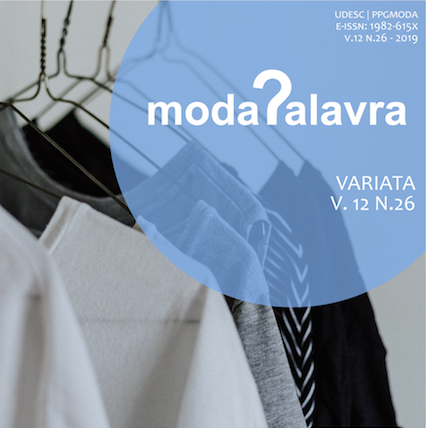Fashion and Digital Fabrication: an emphirical investigation on the benefits of adopting digital fabrication labs as a field of study for fashion in Brazil
DOI:
https://doi.org/10.5965/1982615x12262019117Keywords:
fashion, digital fabrication, 3D print, aser cutterAbstract
This article aim is to present part of a Phd thesis results in which an empirical research has been done in an universitary extension course. The course called “Fashion and Digital Fabrication” offered byFAU-USP Design and Architecture department in collaboration with EACH-USP's Textile and Fashion departmentin association with FabLab Casa da Memória in order to share the knowledge about how to use 3D printers and laser cutter machines within the “maker culture” but also to collect data for the before amentioned research. The main issues annalysed during the course was if it is viable and benefic to adopt practices and tools of the digital fabrication scenario, such as 3D printers and laser cutters, to be applied to the fashionfield. Also we annalized what's the level of absorption of the content by the participants, how they would like to keep using the tools in future works, which groups would benefit of this technics and which possible positive impact could it have in the brazilian contexto.
Downloads
References
BRUNO, F.. “A quarta revolução industrial do setor têxtil e de confecção: a visão de futuro para 2030”. São Paulo: Editora Letras e Cores, 2016
ECHYENNE, F.; NEVES, H. Fablab: a vanguarda da nova revolução industrial. Creative Commons, 2013
FABLAB LIVRE SÃO PAULO. Disponível em: fablablivresp.art.br . Acesso em 30.03.2017
FAB TEXTILES ACADEMY. Disponível em: https://fabtextiles.org/what/. Acesso em: 23.03. 2017. 12h32min
SENNET, R. O artífice. Rio de Janeiro: Editora Record, 2008
SMITH, A; HIELSCHER, S.; DICKEL, S.; SÖRDERBERG, J.; OOST, H. Grassroots digital fabrication: reconfiguring, relocating and recalibrating innovation? In: Science and TechnologyPolicy Research. Disponível em: <https://www.sussex.ac.uk/webteam/gateway/file.php?name=2013-02-swps-aps-sh-gdf-working-paper.pdf&site=25> . Acesso em 03.04.2017. 16h
TEXTILE AND CLOTHING BUSINESS LAB (TCBL). Disponível em: tcbl.eu . Acesso em: 23.03.2017, 14h21min
Downloads
Published
How to Cite
Issue
Section
License
Copyright (c) 2019 Rafaela Blanch Pires

This work is licensed under a Creative Commons Attribution-NonCommercial 4.0 International License.
When submitting an article for publication in ModaPalavra e-periodico, the author (s) agree (s) with the following terms:
- Authors maintain the copyright in their manuscripts and grant the journal the right of first publication, with work simultaneously licensed under the Creative Commons Attribution-NonCommercial 4.0 International, which allows sharing the work with the acknowledgment of authorship and the initial publication in the journal without payment ;
- Authors may use the same results in other publications after the first publication, provided that they indicate ModaPalavra e-journal as the original publication medium;
- Authors are authorized to take additional contracts, separately, only after the original publication in ModaPalavra e-journal, provided they indicate ModaPalavra e-journal as the original publication medium;
- Authors are allowed and encouraged to publish and distribute their work online (eg in institutional repositories or on their personal page), only after the editorial process and the first publication, provided they indicate ModaPalavra e-journal as the original publication medium;
- To indicate ModaPalavra e-journal as the original publication medium, authors should use the following text template: "This article was originally published by ModaPalavra e-periodical, under a CC BY NC license, in its volume [insert volume] number [insert number] in the year of [insert year], and can be accessed at: http://www.revistas.udesc.br/index.php/modapalavra/ ";
- The opinions expressed in the articles are the author’s sole responsibility, not necessarily reflecting the journal’s opinion. The publication of any material that is owned and held in copyright by a third party, including – but not limited to - articles, photos or drawings was previously authorized by their representatives to be published in ModaPalavra e-journal.









